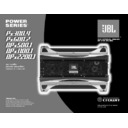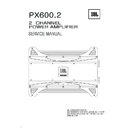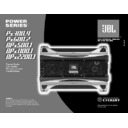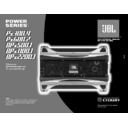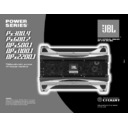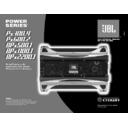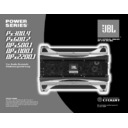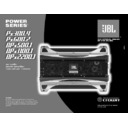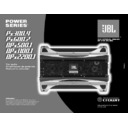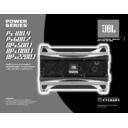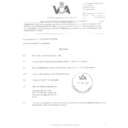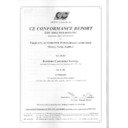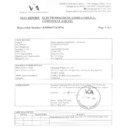JBL PX 600.2 (serv.man3) User Manual / Operation Manual ▷ View online
5
APPLICATIONS – PX300.4
The JBL Px300.4 amplifier can be set up
for stereo or tri-mode operation, as
shown in Figures 6 and 7.
for stereo or tri-mode operation, as
shown in Figures 6 and 7.
NOTE: For simplicity, Figures 6 and 7 do
not show power, remote and input
connections.
not show power, remote and input
connections.
Px300.4
(rear panel)
POWER
FUSES
GND
REM
BATT
Px300.4
SPEAKER OUTPUTS
SPEAKER OUTPUTS
STEREO
REAR
FRONT
L
R
L
R
BRIDGED
NEON
NEON
-
+
+
-
LF
System
System
+
-
RF
System
System
Subwoofer
Set REAR
X-OVER MODE to LP
(on input panel)
FLAT HP
LP
MODE
Set FRONT
X-OVER MODE to HP
(on input panel)
FLAT HP
LP
MODE
Set FRONT
INPUT MODE to ST
(on input panel)
Set REAR
INPUT MODE to MO
(on input panel)
ST
INPUT
MODE
MODE
MO
ST
INPUT
MODE
MODE
MO
See “Setting the Crossover(s)”
on page 6 to set FREQ and SLOPE
Px300.4
(rear panel)
POWER
FUSES
GND
REM
BATT
Px300.4
SPEAKER OUTPUTS
SPEAKER OUTPUTS
STEREO
REAR
FRONT
L
R
L
R
BRIDGED
NEON
NEON
+
-
+
-
LR Speaker
RR Speaker
RF Speaker
LF Speaker
+
-
+
-
Set REAR and FRONT
INPUT MODE to ST
(on input panel)
Set REAR and FRONT
X-OVER MODE to FLAT
(on input panel)
FLAT HP
LP
MODE
ST
INPUT
MODE
MODE
MO
Figure 6. The JBL Px300.4
amplifier is set to stereo mode
to drive front and rear pairs of
full-range speakers.
amplifier is set to stereo mode
to drive front and rear pairs of
full-range speakers.
NOTE: To limit bass sent to
full-range speakers, set
X-OVER MODE to HP. See
page 6 to set FREQ and SLOPE.
full-range speakers, set
X-OVER MODE to HP. See
page 6 to set FREQ and SLOPE.
Figure 7. The JBL Px300.4
amplifier is set to drive a stereo
component system and a
subwoofer with a nominal
impedance of 4 ohms or greater.
amplifier is set to drive a stereo
component system and a
subwoofer with a nominal
impedance of 4 ohms or greater.
NOTE: To drive a pair of rear
midbass speakers (instead of
subwoofer), set INPUT MODE
to ST, X-OVER MODE to LP,
and use DBO to set HP filter.
midbass speakers (instead of
subwoofer), set INPUT MODE
to ST, X-OVER MODE to LP,
and use DBO to set HP filter.
6
INSTALLATION AND SETUP
SETTING THE
OUTPUT MODE
Setting an output mode depends on
your choice of system configuration and
the nominal impedace of your speaker
system. JBL Power Series BPx
amplifiers provide rated power into
any impedance between 1 and 4 ohms.
The BPx500.1, BPx1100.1 and BPx2200.1
amplifiers can be configured to provide
high voltage to loads of 2 ohms or
greater, or high current for loads below
2 ohms.
OUTPUT MODE
Setting an output mode depends on
your choice of system configuration and
the nominal impedace of your speaker
system. JBL Power Series BPx
amplifiers provide rated power into
any impedance between 1 and 4 ohms.
The BPx500.1, BPx1100.1 and BPx2200.1
amplifiers can be configured to provide
high voltage to loads of 2 ohms or
greater, or high current for loads below
2 ohms.
Using the Bridge Mode
If your speaker system has a nominal
impedance of 2 ohms or greater, bridge
the amplifier’s two channels to drive the
speaker(s). On BPx models, set the
OUTPUT MODE switch to 2CH/BR (see
Figure 2 on page 3).
If your speaker system has a nominal
impedance of 2 ohms or greater, bridge
the amplifier’s two channels to drive the
speaker(s). On BPx models, set the
OUTPUT MODE switch to 2CH/BR (see
Figure 2 on page 3).
Using the Parallel Mode
(BPx Models Only)
If the nominal speaker-system
impedance is less than 2 ohms,
connect the two amplifier channels
in parallel to drive the speaker(s),
as shown in Figure 3 on page 3.
On BPx models, set the OUTPUT MODE
switch to PARALLEL.
(BPx Models Only)
If the nominal speaker-system
impedance is less than 2 ohms,
connect the two amplifier channels
in parallel to drive the speaker(s),
as shown in Figure 3 on page 3.
On BPx models, set the OUTPUT MODE
switch to PARALLEL.
NOTE: If the nominal impedance of your
subwoofer system is close to 2 ohms,
try both series and parallel to determine
which mode provides the highest
volume. Use the I/E OPT LED according
to “Setting Input Sensitivity” on the
right.
subwoofer system is close to 2 ohms,
try both series and parallel to determine
which mode provides the highest
volume. Use the I/E OPT LED according
to “Setting Input Sensitivity” on the
right.
Using the 2-Channel Mode
With any Power Series amplifier, you
can also drive two woofers separately
by connecting the speakers in the
2-channel mode (see Figure 1 on page
3). In this mode, the minimum nominal
impedance is 2 ohms. On BPx models,
set the OUTPUT MODE switch to
2CH/BR.
With any Power Series amplifier, you
can also drive two woofers separately
by connecting the speakers in the
2-channel mode (see Figure 1 on page
3). In this mode, the minimum nominal
impedance is 2 ohms. On BPx models,
set the OUTPUT MODE switch to
2CH/BR.
SETTING THE
CROSSOVER(S)
IMPORTANT: If you plan to use the
Px300.4 or Px600.2 to drive full-range
speakers, set the X-OVER MODE
switch(es) to FLAT and skip to the next
section, “Setting Input Sensitivity.”
1. Initially set the X-OVER FREQ
CROSSOVER(S)
IMPORTANT: If you plan to use the
Px300.4 or Px600.2 to drive full-range
speakers, set the X-OVER MODE
switch(es) to FLAT and skip to the next
section, “Setting Input Sensitivity.”
1. Initially set the X-OVER FREQ
control(s) midway. Later, when
listening to music (in the next
section), adjust them for least-
perceived distortion from midrange
and high-frequency speakers, while
allowing them to reproduce as much
bass as possible.
listening to music (in the next
section), adjust them for least-
perceived distortion from midrange
and high-frequency speakers, while
allowing them to reproduce as much
bass as possible.
2. Depending on your system plan, set
the X-OVER MODE switch(es) to LP
(low-pass), HP (high-pass), or FLAT.
(low-pass), HP (high-pass), or FLAT.
3. For HP filters, set the X-OVER SLOPE
switch(es) to 24dB to limit bass and
provide increased system volume
with less distortion.
provide increased system volume
with less distortion.
For LP filters, use 12dB or 24dB
according to taste. However, using
a 24dB slope will make bass less
directional since midrange frequencies
are being filtered from the woofer’s
response. When choosing a low-pass
filter frequency for your subwoofers,
choose the highest frequency that will
remove vocal information from the
sound of the subwoofer.
according to taste. However, using
a 24dB slope will make bass less
directional since midrange frequencies
are being filtered from the woofer’s
response. When choosing a low-pass
filter frequency for your subwoofers,
choose the highest frequency that will
remove vocal information from the
sound of the subwoofer.
SETTING DBO
(ALL MODELS
EXCEPT PX600.2)
Dynamic Bass Optimizer™ (DBO) is
a new approach to enhancing low-
frequency reproduction in a vehicle.
Conventional bass boost controls add
bass at a fixed frequency and cause the
amplifier to consume considerable
power. DBO conserves valuable power
at the lowest frequencies and allows
you to adjust the level and “character”
of the bass sound, instead of just the
amount of boom.
(ALL MODELS
EXCEPT PX600.2)
Dynamic Bass Optimizer™ (DBO) is
a new approach to enhancing low-
frequency reproduction in a vehicle.
Conventional bass boost controls add
bass at a fixed frequency and cause the
amplifier to consume considerable
power. DBO conserves valuable power
at the lowest frequencies and allows
you to adjust the level and “character”
of the bass sound, instead of just the
amount of boom.
Since a subwoofer in a vented box is
given to overexcursion below the tuned
frequency, set the HP FREQ control 10Hz
below the box’s resonant (tuned)
frequency (e.g., 30Hz for a vented box
tuned to 40Hz). Power typically wasted
in this region will now be conserved and
be available for frequencies the
enclosure will reproduce. Use the
BOOST Installation and setup control to
boost the bass at the set frequency by
as much as 12dB, as shown in Figure 8.
given to overexcursion below the tuned
frequency, set the HP FREQ control 10Hz
below the box’s resonant (tuned)
frequency (e.g., 30Hz for a vented box
tuned to 40Hz). Power typically wasted
in this region will now be conserved and
be available for frequencies the
enclosure will reproduce. Use the
BOOST Installation and setup control to
boost the bass at the set frequency by
as much as 12dB, as shown in Figure 8.
Figure 8. Frequency response curves
show typical DBO control ranges for
selected JBL Power Series amplifiers.
show typical DBO control ranges for
selected JBL Power Series amplifiers.
SETTING INPUT
SENSITIVITY
NOTE: For BPx models, you can use the
supplied REMOTE LEVEL CONTROL
instead of the amplifier’s INPUT LEVEL
control to set input sensitivity. Connect
the remote module’s attached cable to
the REMOTE LEVEL CONTROL (RJ-11)
jack on the amplifier’s input panel.
1. Initially, turn the INPUT LEVEL
SENSITIVITY
NOTE: For BPx models, you can use the
supplied REMOTE LEVEL CONTROL
instead of the amplifier’s INPUT LEVEL
control to set input sensitivity. Connect
the remote module’s attached cable to
the REMOTE LEVEL CONTROL (RJ-11)
jack on the amplifier’s input panel.
1. Initially, turn the INPUT LEVEL
control(s) to the minimum
(counterclockwise) position(s).
(counterclockwise) position(s).
2. Reconnect the (–) negative lead to
your vehicle’s battery. Apply power to
the audio system and play a dynamic
music track from CD or tape.
the audio system and play a dynamic
music track from CD or tape.
NOTE: After the source unit is on, blue
LEDs (on the top panel) will illuminate,
indicating the amplifier is on. If not,
check the wiring, especially the
remote connection from the source
unit. Also refer to “Troubleshooting”
on the next page.
LEDs (on the top panel) will illuminate,
indicating the amplifier is on. If not,
check the wiring, especially the
remote connection from the source
unit. Also refer to “Troubleshooting”
on the next page.
3. On the source unit, increase the
volume control to maximum position.
Slowly increase the INPUT LEVEL
control(s) (clockwise) towards three
o’ clock and observe the I-E/OPT LED
(on the amplifier top). At the ideal set-
ting, it should flash on musical peaks,
signifying maximum voltage is being
delivered in the 2-channel or bridge
modes, or maximum current is being
delivered in the parallel mode. If the
I-E/OPT LED is on steadily, the
amplifier is being overdriven. Turn the
INPUT LEVEL control(s) back slightly
until the I-E/OPT LED flashes on
musical peaks.
Slowly increase the INPUT LEVEL
control(s) (clockwise) towards three
o’ clock and observe the I-E/OPT LED
(on the amplifier top). At the ideal set-
ting, it should flash on musical peaks,
signifying maximum voltage is being
delivered in the 2-channel or bridge
modes, or maximum current is being
delivered in the parallel mode. If the
I-E/OPT LED is on steadily, the
amplifier is being overdriven. Turn the
INPUT LEVEL control(s) back slightly
until the I-E/OPT LED flashes on
musical peaks.
-9
-6
-3
0
-12
20
80
Freq. (Hz)
dB
DBO HP FREQ Control
(adjusts cut-off
frequency)
HP FREQ
100Hz
20Hz
-6
0
6
12
-12
20
80
Freq. (Hz)
dB
DBO BOOST Control
(adjusts boost amount
at cut-off frequency)
BOOST
MAX
MIN
7
INSTALLATION AND SETUP
For sealed enclosures, use DBO to
enhance the middle of the bass region.
Set the HP FREQ control to 35Hz to 40Hz
and adjust the BOOST control to taste.
This will make the bass sound bigger
and fuller. Alternatively, for tighter-
sounding bass, set the HP FREQ control
between 45Hz and 50Hz, and also adjust
the BOOST control according to your
preference.
enhance the middle of the bass region.
Set the HP FREQ control to 35Hz to 40Hz
and adjust the BOOST control to taste.
This will make the bass sound bigger
and fuller. Alternatively, for tighter-
sounding bass, set the HP FREQ control
between 45Hz and 50Hz, and also adjust
the BOOST control according to your
preference.
For infinite-baffle applications, set the
HP FREQ control to the speaker’s F
HP FREQ control to the speaker’s F
S
value (to keep the subwoofer from
trying to create bass below the
resonant frequency) and adjust the
BOOST control to taste.
trying to create bass below the
resonant frequency) and adjust the
BOOST control to taste.
INSTALLING NEON TUBES
(OPTIONAL)
1. Using a Phillips screwdriver, remove
(OPTIONAL)
1. Using a Phillips screwdriver, remove
all screws on the amplifier’s
output/power end panel and set them
aside.
output/power end panel and set them
aside.
2. Using a 3⁄32-inch Allen wrench,
remove only the screws on the
amplifier’s (top) clear cover and set
them aside.
amplifier’s (top) clear cover and set
them aside.
3. Remove the end panel and slide the
cover off. Set both parts aside.
4. Locate the enclosed hardware bag
and remove the four clips. Each clip
has a square end and a larger round
end. Using a round end, press two
clips onto each neon tube (e.g., Street
Glow AN9 or equivalent), as shown in
Figure 9 below.
has a square end and a larger round
end. Using a round end, press two
clips onto each neon tube (e.g., Street
Glow AN9 or equivalent), as shown in
Figure 9 below.
5. For each tube, align both clips so the
square ends slide onto an exposed
extrusion edge, as shown in Figure 9.
Do not cover any screw holes. When
installed correctly, each neon tube
will sit under an extrusion and not be
visible when viewed from directly
above.
extrusion edge, as shown in Figure 9.
Do not cover any screw holes. When
installed correctly, each neon tube
will sit under an extrusion and not be
visible when viewed from directly
above.
6. Route each neon tube’s power cable
through its respective NEON hole on
the end panel (see Figure 9).
the end panel (see Figure 9).
7. Slide the cover back into place and
reinstall its screws. Then, replace the
end panel and reinstall its screws.
end panel and reinstall its screws.
8. Finish the installation of the neon
tubes as instructed in their owner’s
manual.
manual.
POWER
FUSES
GND
REM
BA
TT
SPEAKER OUTPUTS
BRIDGED
STEREO
Px600.2
L
R
NEON
NEON
PROTECT
POWER
I-E OPT
Installing A Clip
On Extrusion Lip
(side view)
On Extrusion Lip
(side view)
Clip
Neon
Tube
Neon Tube
and Clip
Lip
Installed Neon Tube
Under Extrusion Lip
Under Extrusion Lip
Clip
Clip
To Neon
Power
Supply
To Neon
Power
Supply
Px600.2 Amplifier
(top view with clear cover off)
Output/Power
End Panel
Figure 9.
Installing neon tubes in a JBL Px600.2 amplifier.
Installation is similar for other models.
Installing neon tubes in a JBL Px600.2 amplifier.
Installation is similar for other models.
TROUBLESHOOTING
SYMPTOM
LIKELY CAUSE
SOLUTION
No audio
No voltage at BATT+
Check voltages at
(POWER LED
or REM terminals,
amplifier terminals
is off)
or bad or no ground
with VOM
connection
No audio
DC voltage on
Amplifier may need
(PROTECT LED
amplifier output
service; see enclosed
flashes every
warranty card for
4 sec.)
service information
No audio
Amplifier is
Make sure amplifier
(PROTECT
overheated
cooling is not blocked
LED is on)
at mounting location;
verify speaker-system
impedance is within
specified limits (see
“Specifications” on the
next page)
verify speaker-system
impedance is within
specified limits (see
“Specifications” on the
next page)
No audio
Voltage less than 9V on
Check vehicle
(PROTECT
BATT+ connection
charging system for
and POWER
defective voltage
LEDs flash)
regulator
I-E/OPT LED
Amplifier is being
Check INPUT
is on all times
overdriven
LEVEL setting;
(not flashing)
see previous page
No audio
Voltage more than 16V
Check vehicle
(PROTECT
or less than 8.5V on
charging system for
LED is on)
BATT+ connection
defective voltage
regulator
Distorted audio
Input sensitivity is
Check INPUT
not set properly, or
LEVEL setting; or
amplifier or source
check speaker wires
unit is defective
for shorts or grounds
Distorted audio
Short circuit in
Remove speaker leads
and PROTECT
speaker or wire
one at a time to locate
LED flashes
shorted speaker or
wire, then repair
wire, then repair
Music lacks
Speakers are not
Check speaker
“punch”
connected properly
connections for
proper polarity
proper polarity
Px300.4
Px600.2
BPx500.1
BPx1100.1
BPx2200.1
Power Output,
75W x 4
150W x 2
N/A
N/A
N/A
4 Ohms
Power Output,
150W x 4
300W x 2
250W x 2
575W x 2
1100W x 2
2 Ohms
Power Output,
300W x 2
600W x 1
500W x 1
1100W x 1
2200W x 1
Bridged, 4 Ohms
Power Output,
N/A
N/A
500W x 1
1100W x 1
2200W x 1
Parallel, 1 Ohm
Min. Speaker
2 ohms
2 ohms
1 ohm
1 ohm
1 ohm
Impedance
Frequency
11Hz ~ 45kHz, +1dB
10Hz ~ 45kHz, +1dB
20Hz ~ 320Hz, –3dB
20Hz ~ 320Hz, –3dB
20Hz ~ 320Hz, –3dB
Response
Input Sensitivity
250mV ~ 6V
250mV ~ 6V
250mV ~ 6V
250mV ~ 6V
250mV ~ 6V
(RCA type)
THD + Noise
0.04%
0.04%
0.5%
0.5 %
0.5 %
(4 Ohms)
Signal-to-Noise
95dB
95dB
93dB
93dB
93dB
Maximum
78A
78A
50A
110A
190A
Current Draw
Fuse
30A x 2
30A x 2
30A x 2
30A x 3
150A x 1 external fuse
Replacement
Dimensions
(H x W x L)
(H x W x L)
312mm x 432mm x 66mm
312mm x 432mm x 66mm
312mm x 330mm x 66mm
312mm x 432mm x 66mm
312mm x 555mm x 66mm
SPECIFICATIONS
Declaration of Conformity
We, Harman Consumer International
2, route de Tours
72500 Chateau-du-Loir
FRANCE
72500 Chateau-du-Loir
FRANCE
declare in own responsibility, that the product
described in this owner’s manual is in compliance
with technical standards:
described in this owner’s manual is in compliance
with technical standards:
EN 55013/A14:1999
EN 55020/A14:1999
EN 55020/A14:1999
Emmanuel Millot
Harman Consumer
International
Chateau-du-Loir, France 5/03
* BPx500.1, BPx1100.1 and BPx2200.1 amplifiers are
performance-engineered by Crown.
JBL Consumer Products
250 Crossways Park Drive, Woodbury, NY 11797 USA
© 2003 Harman International Industries, Incorporated
JBL and Power Series are registered trademarks,
and Dynamic Bass Optimizer is a trademark, of
Harman International Industries, Incorporated.
and Dynamic Bass Optimizer is a trademark, of
Harman International Industries, Incorporated.
Part No. PSAMPOM5/03
www.jbl.com
English
Display

